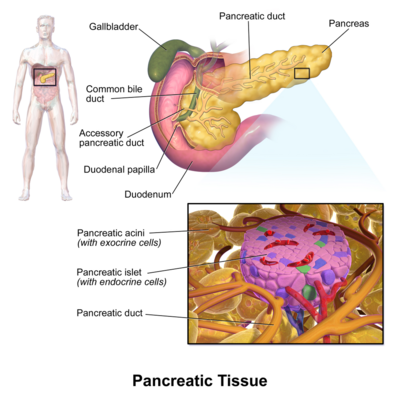Pramlintide in the Treatment of Diabetes Mellitus
Original Editor - Ashton Randolph
Top Contributors - Lucinda hampton, Ashton Randolph, Vidya Acharya, Breonna Tucker and Aminat Abolade
Introduction[edit | edit source]
Pramlintide is a man-made form of a hormone (amylin) designed to be used in conjunction with insulin for patients who fail to control their glycemic levels with insulin alone [1]. Amylin is secreted along with insulin by Beta cells located within the pancreas [2].
Pramlintide lowers blood sugar in three ways:
- It slows the rate that food moves from your stomach to your intestines, which keeps your blood sugar from rising too fast.
- Lowers the amount of glucose your liver produces.
- Triggers the feeling of fullness after meals to help control your appetite and decrease how much food you eat[3].
Pramlintide is similar in its structure and function to islet amyloid polypeptide (IAPP), which is a hormone secreted along with insulin by Beta cells located within the pancreas [2]. The role of this hormone is to aid in controlling postprandial hyperglycemia, by suppressing glucagon secretion, reducing the rate of gastric emptying, and regulating food intake by sending satiety signals to the brain.
Administration[edit | edit source]
- Pramlintide is injected under the skin, at the same time the insulin injection is, but in a separate injection (never mix pramlintide and insulin together in the same syringe).
- Pramlintide is usually given just before each major meal. If a meal is skipped, also skip your pramlintide dose.
- Client uses a different place on the stomach or thigh each time they use the injection. The insulin injection should be in a separate skin area[3].
Physiotherapy[edit | edit source]
Physical therapist should be aware of adverse effects associated with Pramlintide.
- While exercising, the therapist should watch the patient for symptoms of hypoglycemia including anxiety, tingling and numbness in the arms and legs, chills, sweats, and unsteady gait [4]. The major adverse effect of Pramlintide is hypoglycemia because it is taken concurrently with insulin [5].
- During treatment avoid applying physical agents or massage around the injection site because it can change the drug absorption from subcutaneous tissues.
- Physical therapist should also encourage patients to eat a healthy diet and monitor blood glucose before and after exercise.
Exercise Education: Aerobic exercises will help improve insulin sensitivity, increase blood flow to extremities, and maintain a healthy weight[6].
Back to Pharmacological Management of Diabetes Mellitus[edit | edit source]
References[edit | edit source]
- ↑ Łoboda, D., & Rowińska-Żyrek, M. (2017). Zn(II) - pramlintide: Stability, binding sites and unexpected aggregation. Journal of Inorganic Biochemistry,174, 150-155. doi:10.1016/j.jinorgbio.2017.06.008
- ↑ 2.0 2.1 Hinshaw L, Schiavon M, Dadlani V, et al. Effect of Pramlintide on Postprandial Glucose Fluxes in Type 1 Diabetes. J Clin Endocrinol Metab. 2016;101(5):1954-62.
- ↑ 3.0 3.1 Drugs.com Pramlintide Available: https://www.drugs.com/mtm/pramlintide.html(accessed 26.9.2021)
- ↑ Triplitt CL, Reasner CA. Diabetes mellitus, In: DiPiro JT, et al, eds. Pharmacotherapy: A Pathophysiologic Approach. 8th ed. New York: McGraw-Hill; 2011.
- ↑ Ryan, G. J., Jobe, L. J., & Martin, R. (2005). Pramlintide in the treatment of type 1 and type 2 diabetes mellitus. Clinical Therapeutics,27(10), 1500-1512. doi:10.1016/j.clinthera.2005.10.009
- ↑ Colberg SR, Sigal RJ, Fernhall B, et al. Exercise and type 2 diabetes: the American College of Sports Medicine and the American Diabetes Association: joint position statement. Diabetes Care. 2010;33(12):e147-67.








